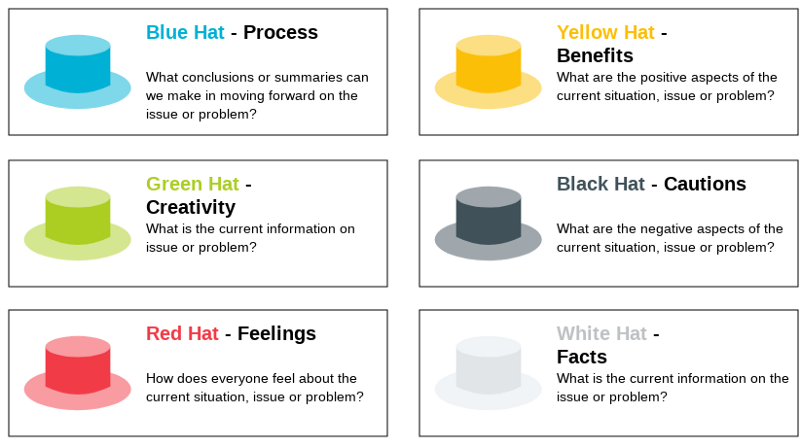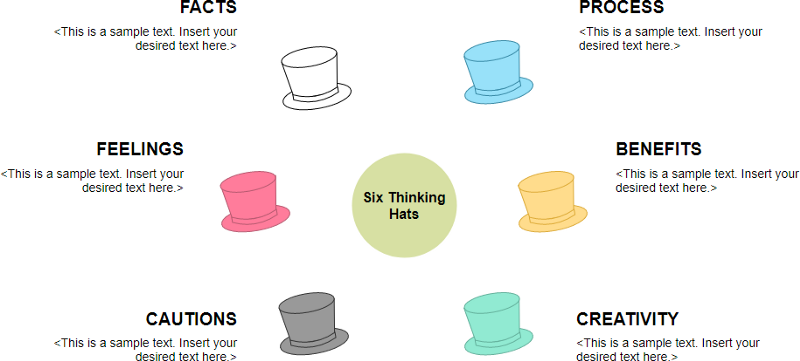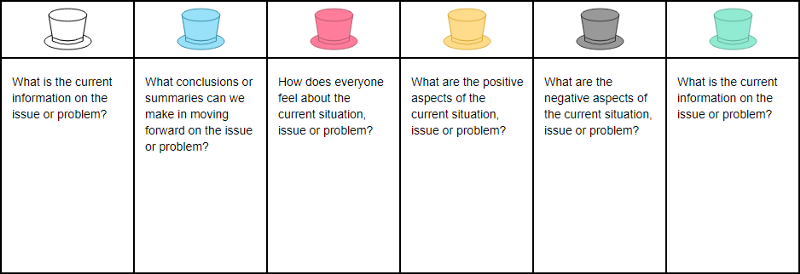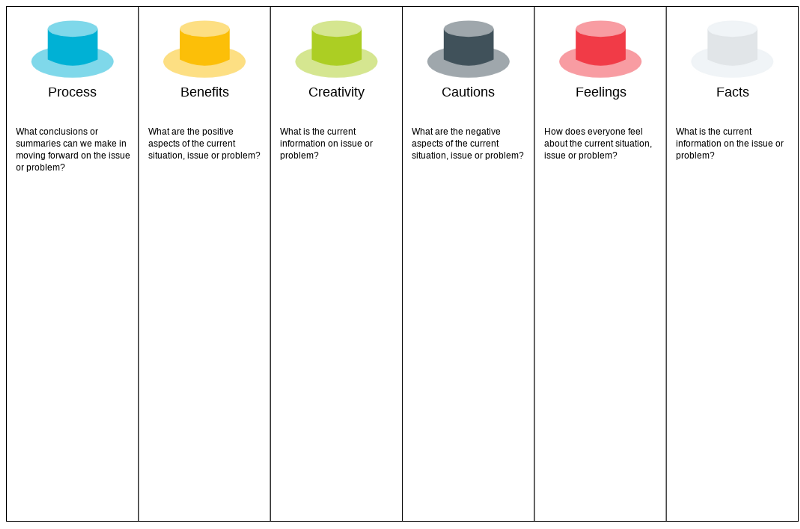Podczas spotkania często zdarza się, że ludzie używają różnych procesów myślowych, co może utrudniać prowadzenie sensownej dyskusji. Na przykład, osoby odnoszące sukcesy myślą z bardzo racjonalnego, pozytywnego punktu widzenia. Podobnie, pesymiści mogą być nadmiernie defensywni, a bardziej emocjonalni ludzie mogą nie potrafić spojrzeć na decyzje spokojnie i racjonalnie.
technika sześciu kapeluszy myślowych, zaproponowana przez Edwarda de Bono w 1999 roku, zachęca grupę do podejścia do omawianego zagadnienia z różnych perspektyw. Zmusza to zespół do wyjścia poza ich nawykowy styl myślenia i pomaga uzyskać bardziej wszechstronny obraz sytuacji. Jest to ważna i potężna technika do debaty nad zagadnieniem, rozwiązania problemu lub podjęcia ważnej decyzji.

Edytuj powyższy przykład online
Jak przeprowadzić proces Sześciu Kapeluszy Myślowych?
W sześciu kapeluszach myślowych, wszyscy myślą o tych samych zagadnieniach w tym samym czasie, zakładając sześć różnych metaforycznych kapeluszy. Każdy kapelusz ma inny kolor i reprezentuje określony typ procesu myślowego.
Na spotkaniach ma to zaletę blokowania konfrontacji, które występują, gdy osoby o różnych stylach myślenia omawiają ten sam problem. Każdy 'Kapelusz Myślowy’ to inny styl myślenia. Poniżej przedstawiono ich wyjaśnienia:
Technika Sześciu Kapeluszy Myślowych została specjalnie zaprojektowana tak, aby wszyscy myśleli równolegle, używając tylko jednego kapelusza w danym czasie. Proces działa najlepiej z limitem czasowym (maksymalnie 5 minut) dla każdego kapelusza. To zachęca grupę do 'przymierzania innych kapeluszy’ i szczególnie pomaga osobom, które mogą mieć bardzo zakorzenione poglądy, rozważyć pomysł z różnych perspektyw.
Biały Kapelusz — Fakty i Informacje
Obejmuje to fakty, liczby, potrzeby informacyjne i luki. Zajmuje się tym, co jest znane i jakie informacje mogą być brakujące. Skojarzenie jest z papierem, na którym zapisywane są 'fakty’.
Czerwony Kapelusz — Uczucia i Intuicja
Obejmuje to intuicję, uczucia i emocje. Skupia się na tym, co ludzie czują w związku z omawianym zagadnieniem. Ważne jest, że nie ma potrzeby racjonalizowania ani wyjaśniania.
Czarny Kapelusz — Ostrożność i Problemy
To jest kapelusz osądu i ostrożności. Jest to najcenniejszy kapelusz. Skupia się tutaj na problemach, ryzykach i wyzwaniach, które może stwarzać ten pomysł.
Żółty Kapelusz — Korzyści i Zalet
To jest logiczna pozytywna — dlaczego coś zadziała i dlaczego przyniesie korzyści. Może być używane w oczekiwaniu na wyniki jakiejś proponowanej akcji, ale może być również używane do znalezienia czegoś wartościowego w tym, co już się wydarzyło.
Niebieski Kapelusz — Zarządzanie Myśleniem
To jest kapelusz przeglądowy lub kontrolny procesu. Czy możesz podsumować dotychczasowe ustalenia? Co należy zrobić następnie?
Zielony Kapelusz — Kreatywność i Rozwiązanie
To jest kapelusz kreatywności, alternatyw, propozycji, tego, co jest interesujące, prowokacji i zmian. Ten kapelusz jest często używany podczas burzy mózgów do generowania pomysłów.
Szablon Sześciu Kapeluszy Myślowych — Styl Diagramu Konceptualnego

Inny Szablon Sześciu Kapeluszy Myślowych

Edytuj powyższy przykład online
Szablon Modelu Sześciu Kapeluszy Myślowych

Edytuj powyższy przykład online
Ten post dostępny jest również w Deutsch, English, Español, فارسی, Français, Bahasa Indonesia, 日本語, Portuguese, Ру́сский, Việt Nam, 简体中文 and 繁體中文













